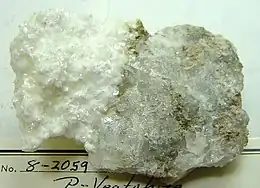| Veatchite | |
|---|---|
 Veatchite-p, Billie Mine, Death Valley, California | |
| General | |
| Category | Phylloborates |
| Formula (repeating unit) | Sr2B11O16(OH)5 · H2O |
| IMA symbol | Vea[1] |
| Strunz classification | 6.EC.15 |
| Crystal system | Monoclinic |
| Crystal class | Domatic (m) (same H-M symbol) |
| Space group | Aa |
| Unit cell | a = 20.81 Å, b = 11.74 Å c = 6.63 Å; β = 92.03°; Z = 8 |
| Identification | |
| Color | Colorless to white |
| Crystal habit | Flattened platey to prismatic crystals, diverging fibrous clusters and cross fiber veinlets |
| Cleavage | Perfect on {010}, indistinct on {001} |
| Mohs scale hardness | 2 |
| Luster | Vitreous to pearly |
| Diaphaneity | Transparent to translucent |
| Specific gravity | 2.62 |
| Optical properties | Biaxial (+) |
| Refractive index | nα = 1.551 nβ = 1.553 nγ = 1.620 |
| Birefringence | δ = 0.069 |
| 2V angle | Measured: 37° |
| References | [2][3][4] |
Veatchite is an unusual strontium borate, with the chemical formula Sr2B11O16(OH)5·H2O. There are two known polytypes, veatchite-A and veatchite-p.[5]
Veatchite was discovered in 1938, at the Sterling Borax mine in Tick Canyon, Los Angeles County, California. Veatchite is named to honor John Veatch, the first person to detect boron in the mineral waters of California.
See also
References
- ↑ Warr, L.N. (2021). "IMA–CNMNC approved mineral symbols". Mineralogical Magazine. 85 (3): 291–320. Bibcode:2021MinM...85..291W. doi:10.1180/mgm.2021.43. S2CID 235729616.
- ↑ Veatchite on Mindat.org
- ↑ Veatchite data on Webmineral
- ↑ Veatchite in the Handbook of Mineralogy
- ↑ Grice J D, Pring A (2012) Veatchite: structural relationships of the three polytypes, American Mineralogist 97, 489-495
External links
![]() Media related to Veatchite at Wikimedia Commons
Media related to Veatchite at Wikimedia Commons
This article is issued from Wikipedia. The text is licensed under Creative Commons - Attribution - Sharealike. Additional terms may apply for the media files.